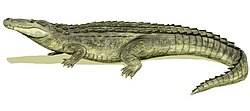| Alligatorinae | |
|---|---|
 | |
| Scientific classification | |
| Kingdom: | Animalia |
| Phylum: | Chordata |
| Class: | Reptilia |
| Clade: | Archosauria |
| Order: | Crocodilia |
| Superfamily: | Alligatoroidea |
| Family: | Alligatoridae |
| Subfamily: | Alligatorinae Gray, 1844 |
| Genera | |
Alligatorinae is a subfamily within the family Alligatoridae that contains the alligators and their closest extinct relatives, and is the sister taxon to Caimaninae (the caimans). Many genera in Alligatorinae are described, but only the genus Alligator is extant, with the remaining being extinct.


